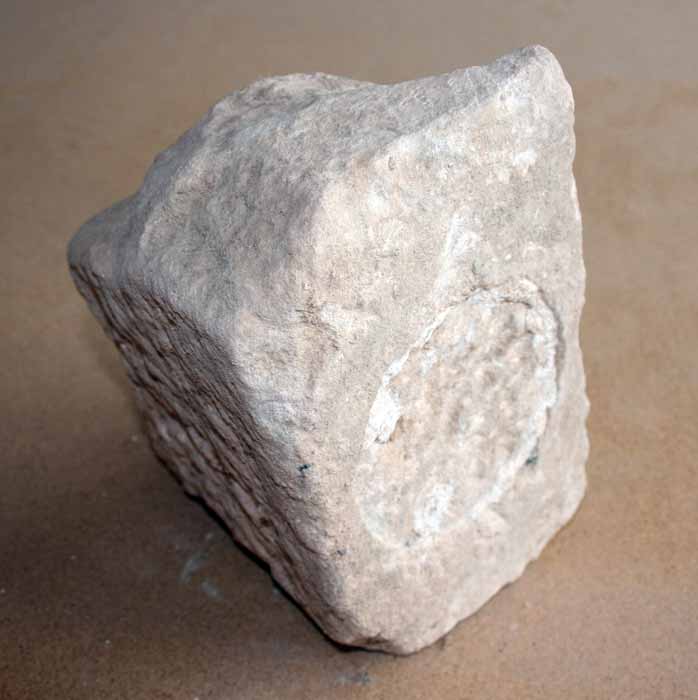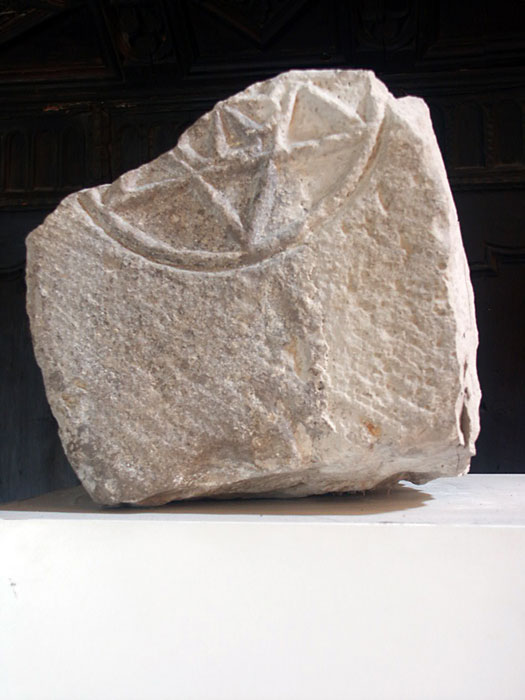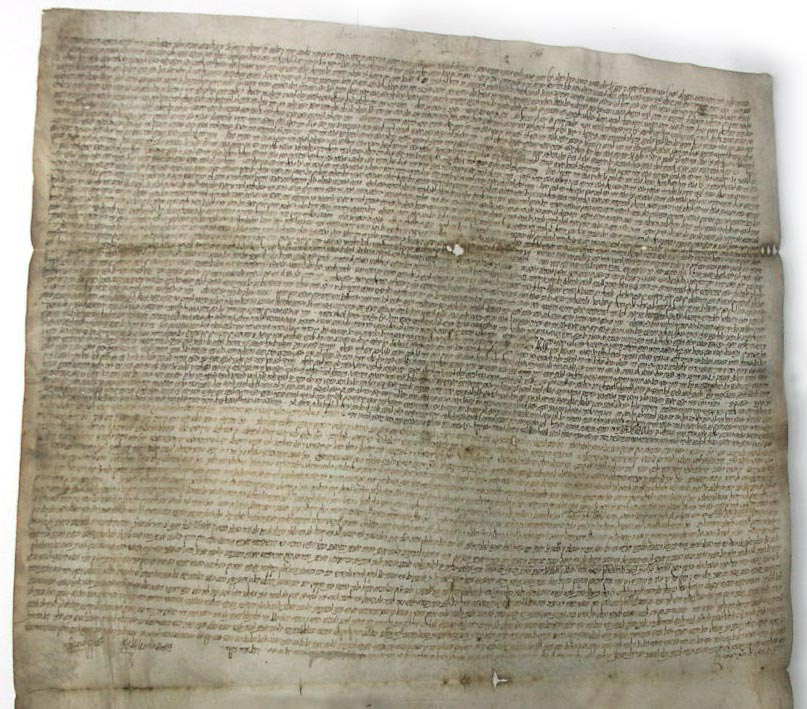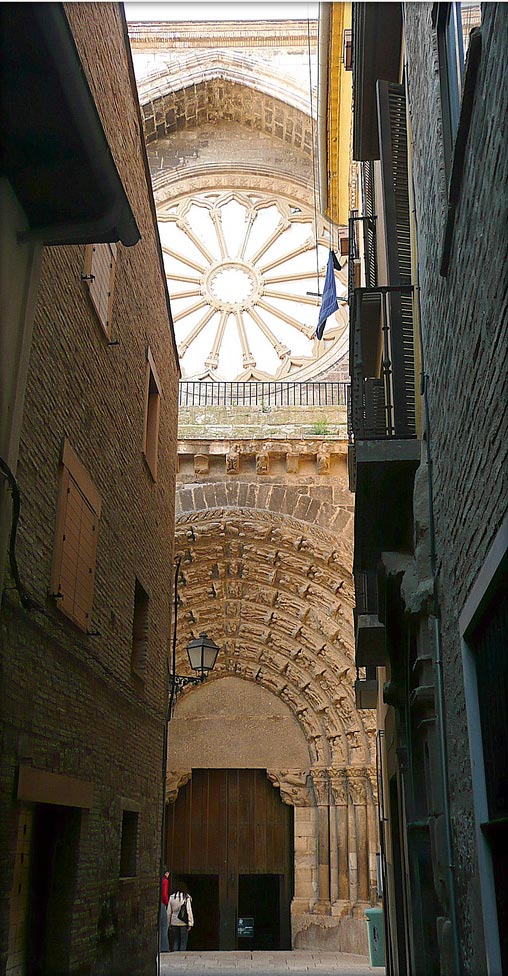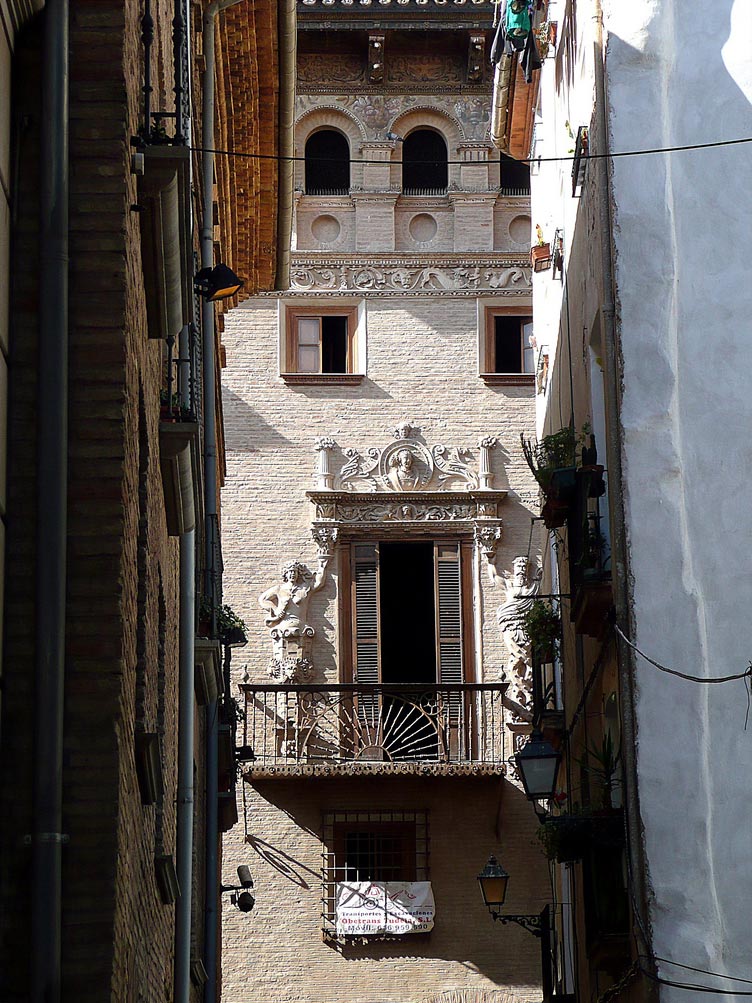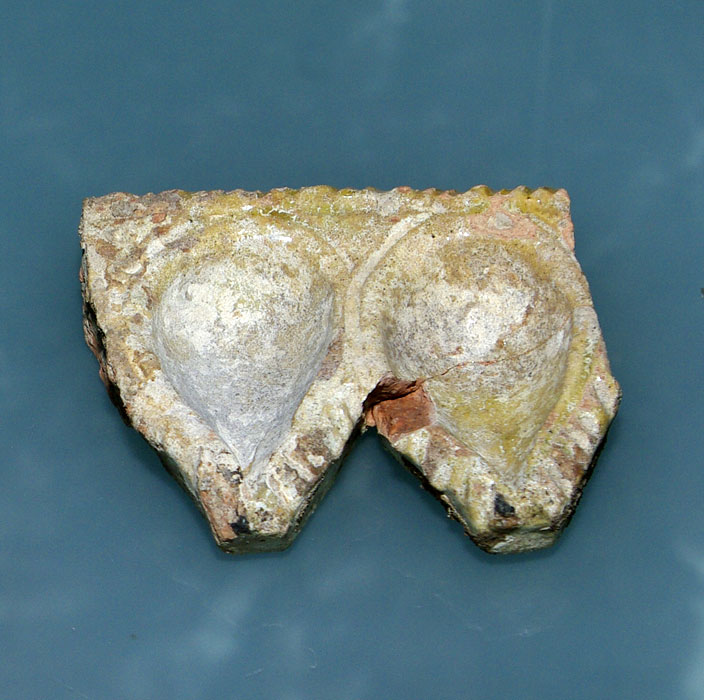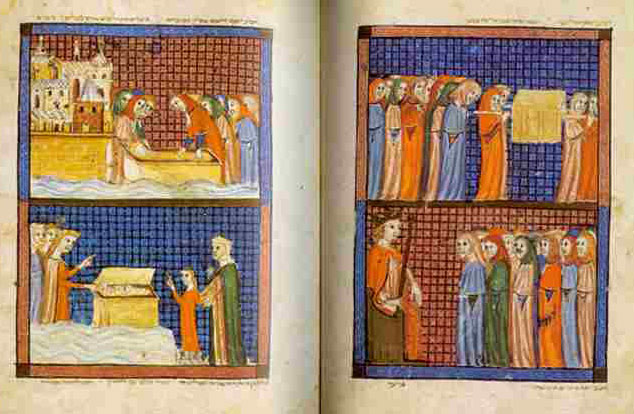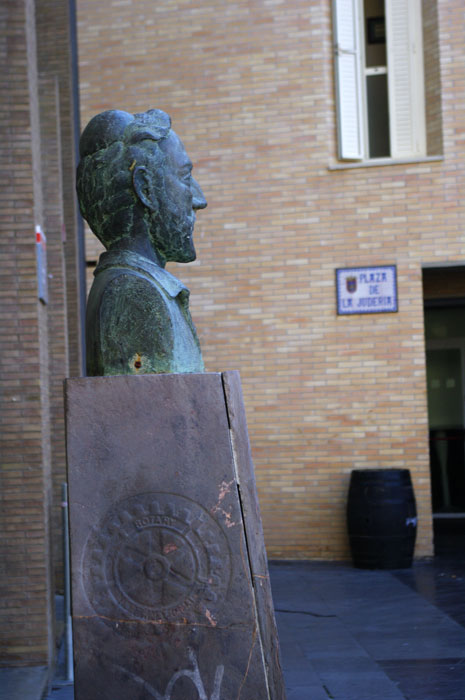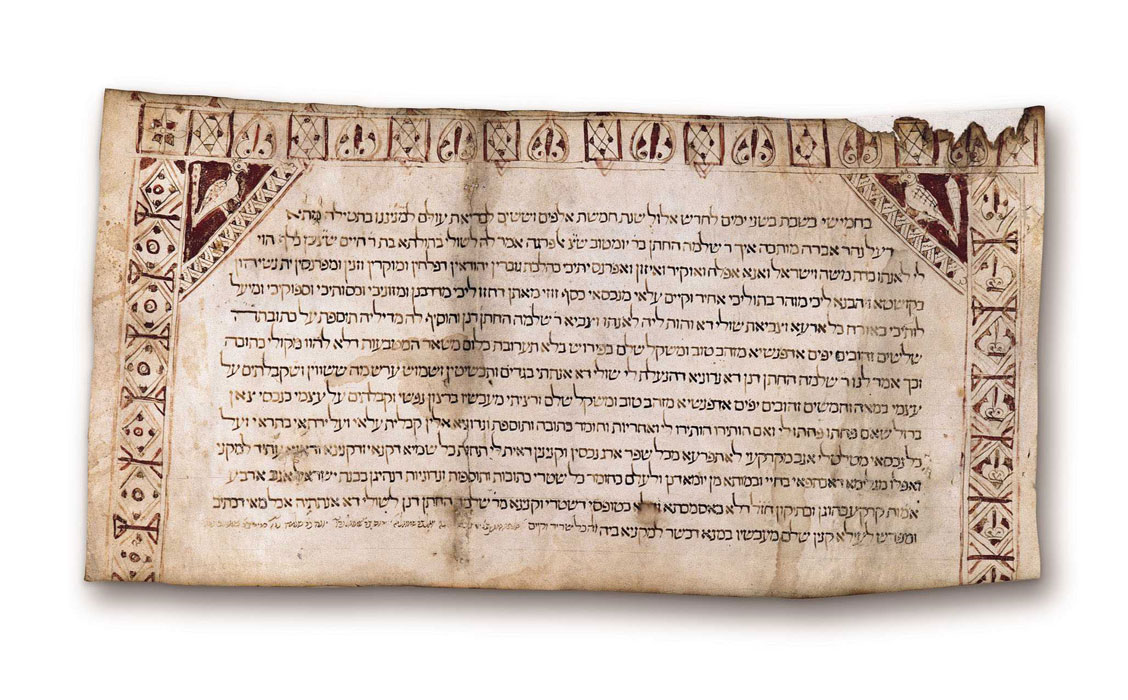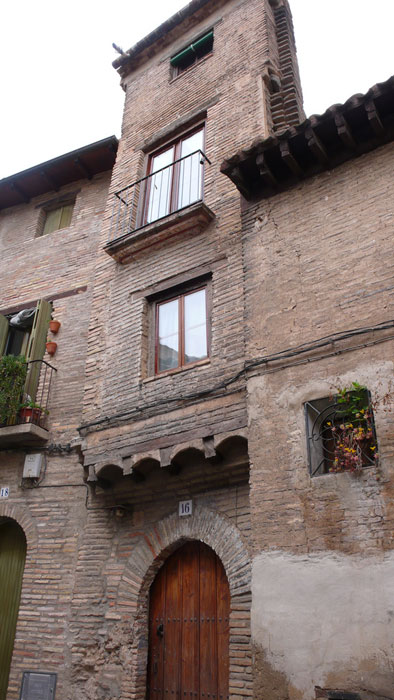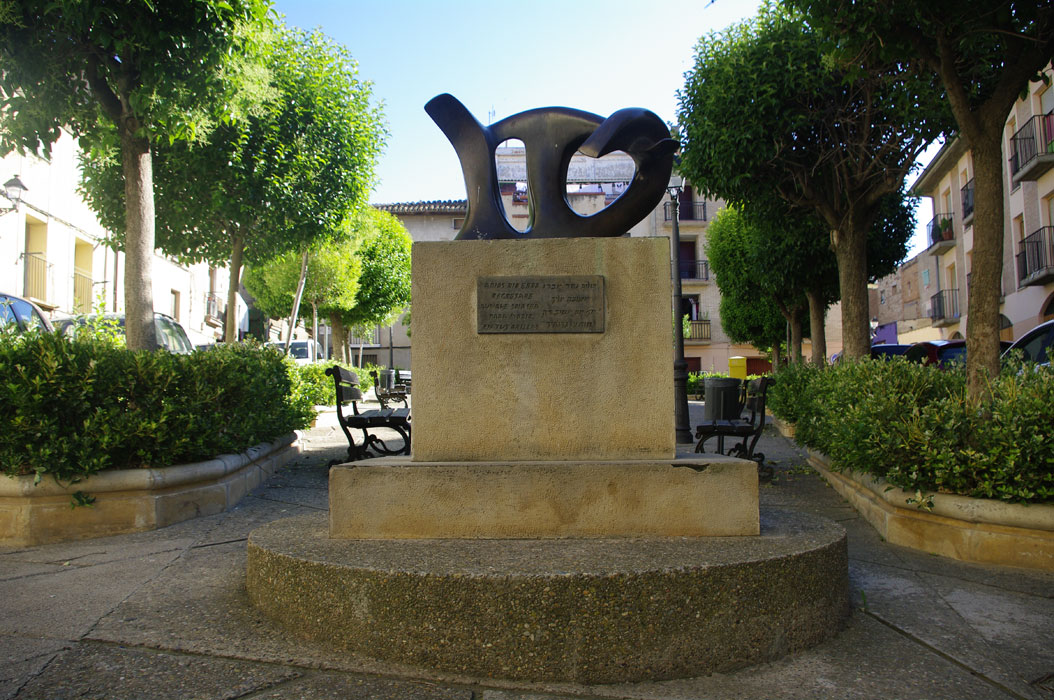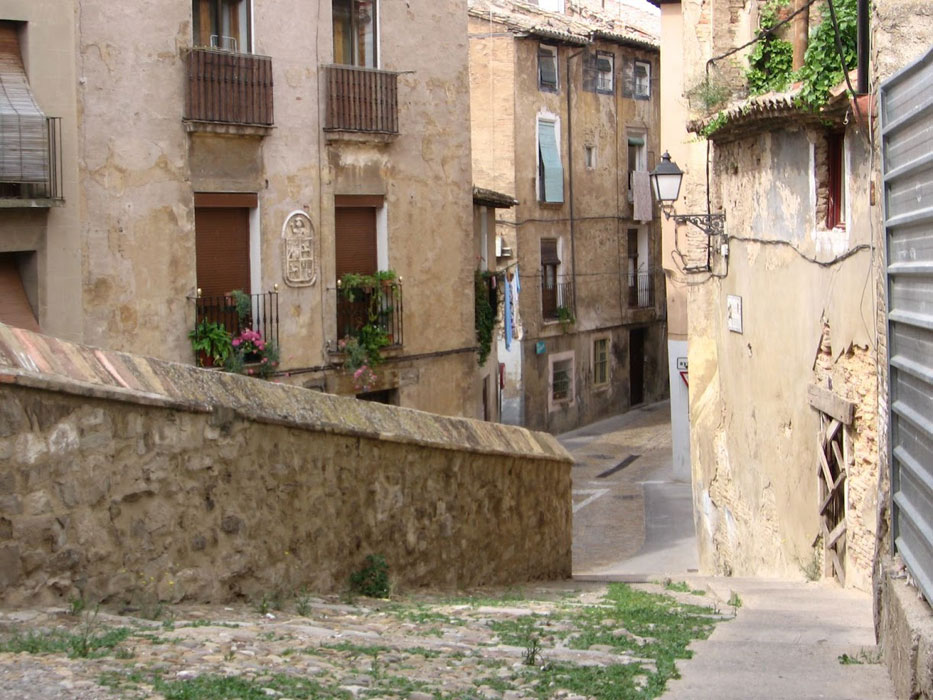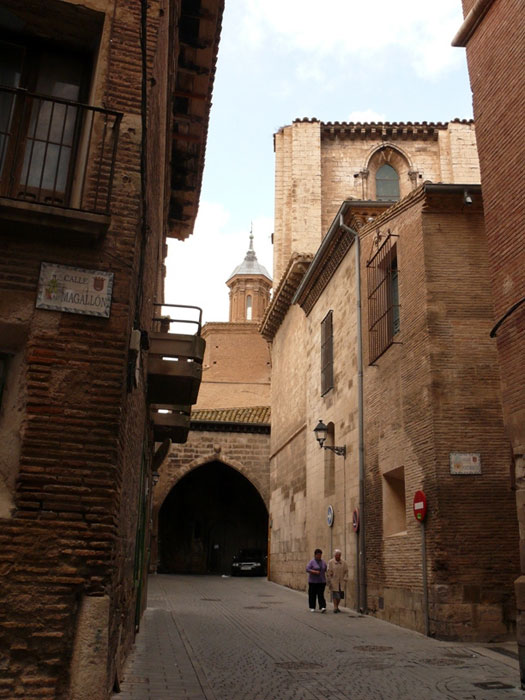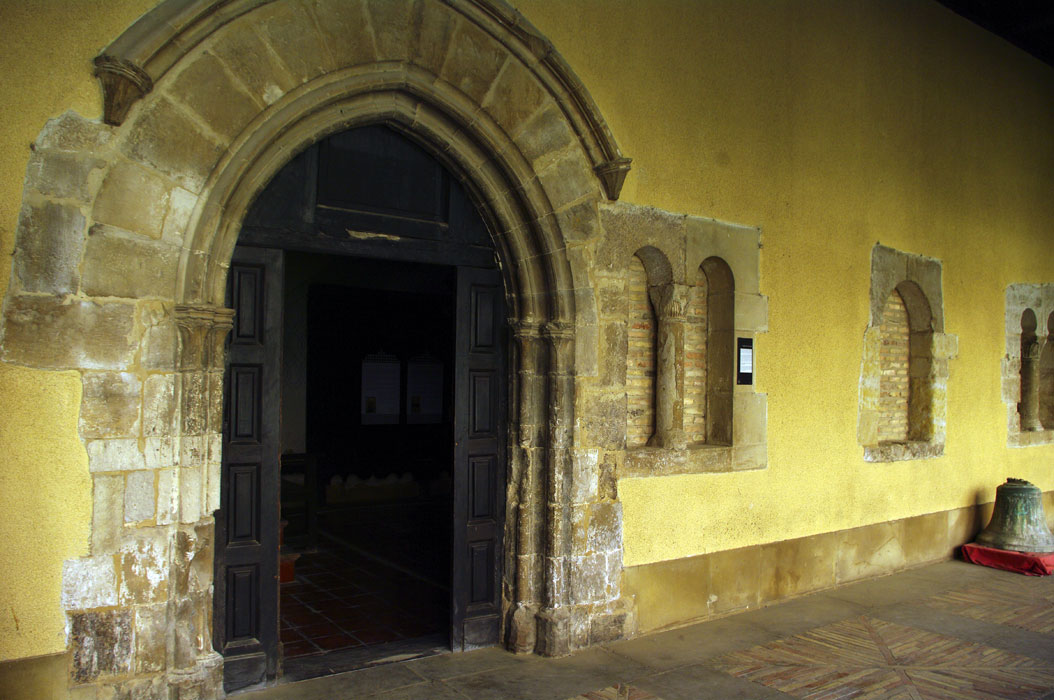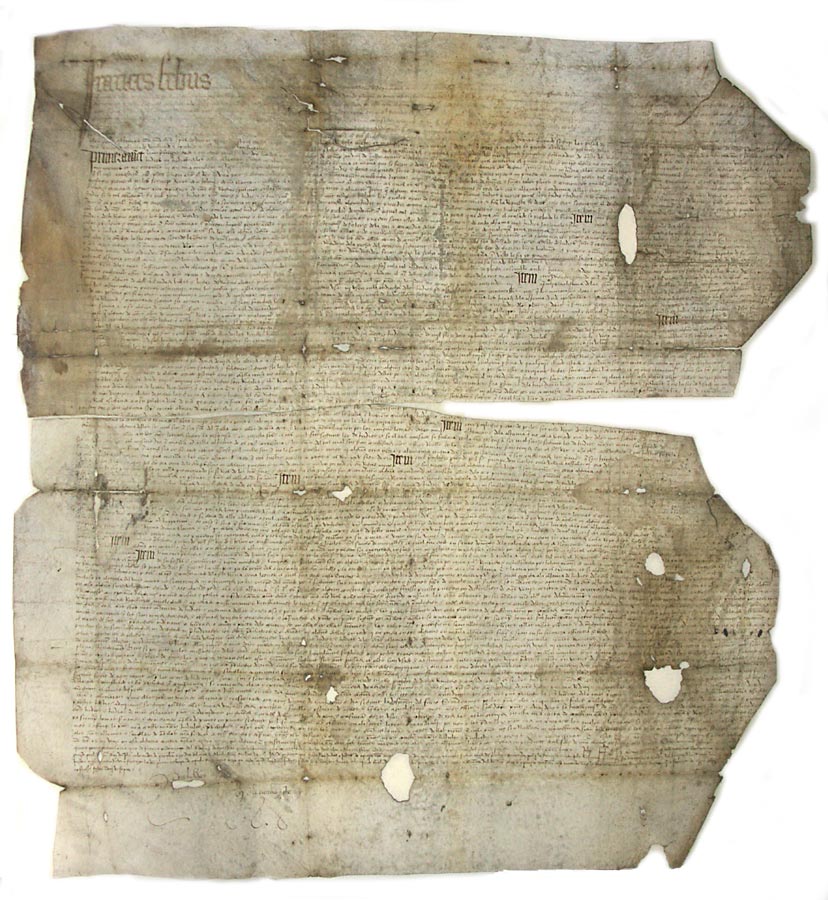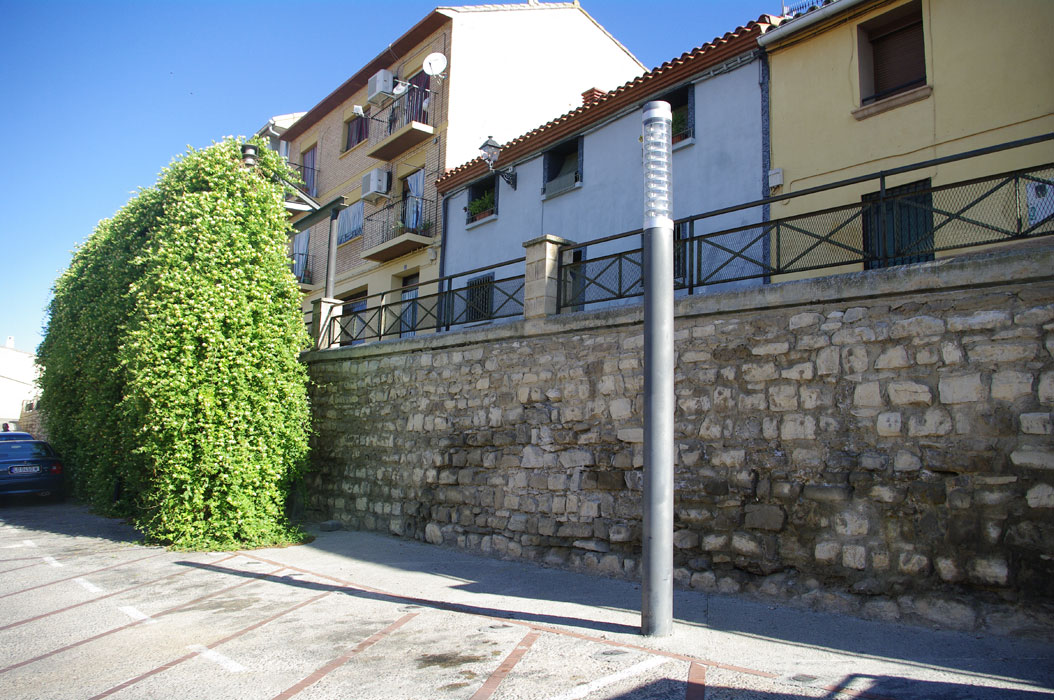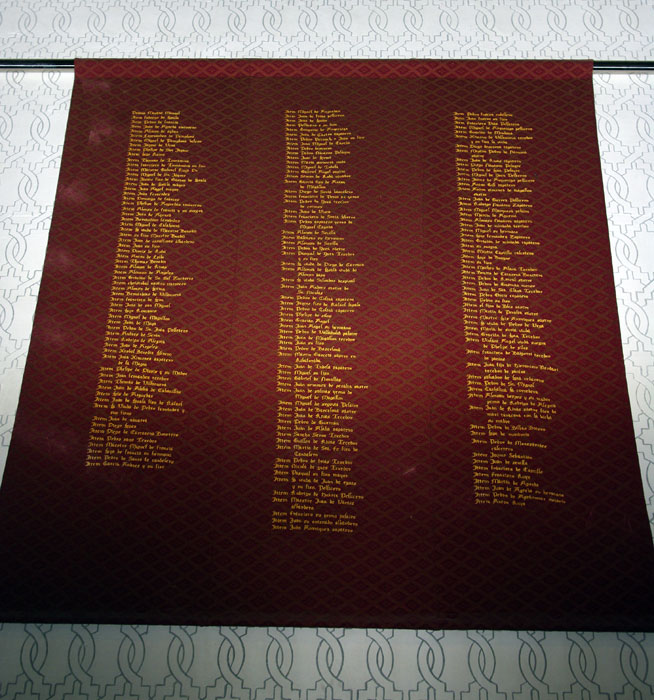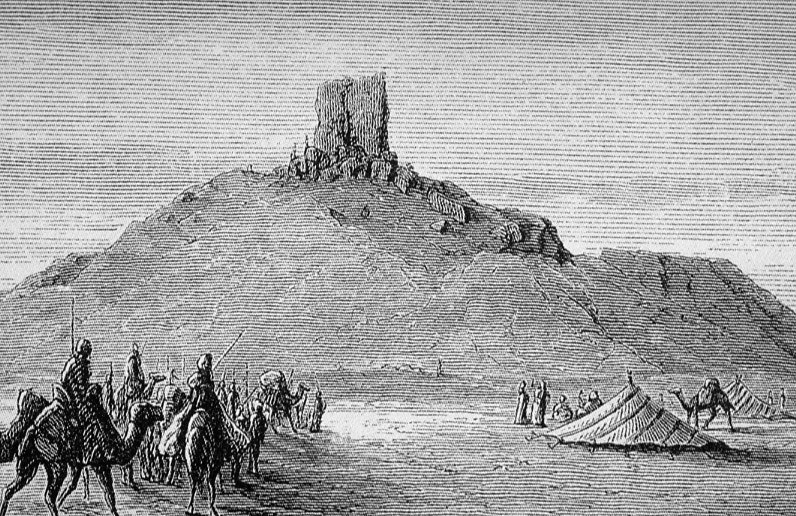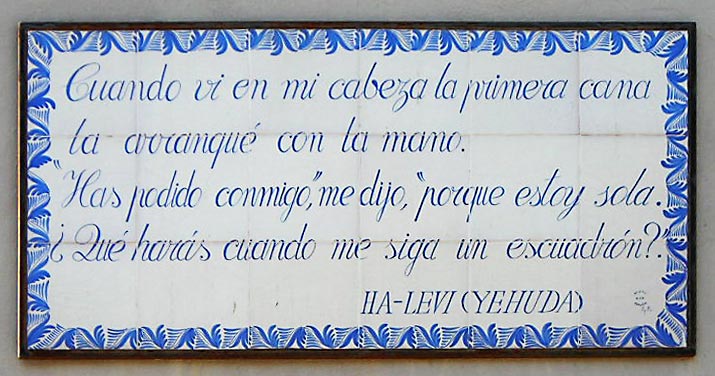With its Christian cathedral whose heart is Jewish and Moslem, its old city set between
a Moorish quarter and two Jewish quarters, its famous Al-Andalus and Hebrew figures
renowned worldwide, Tudela is a unique city endowed with three cultures and situated
right in the heart of the Kingdom of Navarre. The Old Jewish quarter and the New Jewish quarter, with an intermediate path spattered with constant evocations
of the time when the Hebrews inhabited the city, today afford a surprising tour which
allows a major part of the historic city to be discovered through its Jews.
Founded by the Arabs in 797, in Tudela there is no Jewish presence mentioned until
the reconquest of the city in 1119, but it is widely accepted that the first Hebrew settlers arrived in Tudela in around 802, almost concurrently with the Moslem foundation of
the city as a stronghold in the Marca del Ebro at a point equidistant between Saragossa,
Logroño, Pamplona and Soria. The Muladi from Huesca, Amrus ibn Yusuf, the deputy of the emir Al Hakán I, was commissioned to build a bridge over the Ebro and set up the first population
core which, as the years go by, was converted into a prosperous city surrounded by
a fertile, mild environment as related by the Arab geographer Al Razí in his Crónica del moro Rasis (Chronicle of the Moor Rasis) in 919,.
For over three centuries the Moslem Tudela formed an important commercial and cultural
nucleus in northern Spain, an aspect which was further stepped up after the fall of
the Caliphate of Córdoba and the binding of the city to the taifa of Saragossa under
Banud Hud. From this time we have the famous 23 biographies of famous personalities
from the Moslem world of Tudela and this melting pot was also inhabited by the great
Jewish names whose fame had survived until today.
Around the year one thousand, as the Cordoban Caliphate fell into ruin and extinction,
the ruler Tuybíes of the great taifa of Saragossa became the lords of Tudela when the Omeya Caliphate
of Córdoba ended. The first three rulers had as their deputy or Caid of Tudela and Lérida Sulayman ibn Hud, of Yemeni stock who, at the age of twenty, drove them out of power (1038). One of
his sons, Mundir ibn Sulayman «al-Zafir» (the Triumphant), governed with sufficient autonomy to coin currency in
the small taifa kingdom of Tudela (1046- 1051) until he was usurped by his brother
the brilliant Abu Chafar Ahmad al-Muqtadir (1046-1081), the builder of the Saragossan palace of Aljafería and patron of wise
men and scholars. With the aid of the enlightened environment of the Hudí court of
Saragossa, the great personalities known by everyone flourished: the excellent poet
Yehuda-ha-Leví (circa 1070-1141), the polygrapher Abraham ibn Ezrá (1089-1164) and the illustrious traveller Benjamín of Tudela (circa 1130-1175). In the eyes of its contemporaries, Tudela was a prestigious centre of
Judeo-Arab culture.
The taifa fell after the defeat and death in Valtierra of Ahmad Al-Mustain, the grandson
of Al Muqtadir, killed by knights from Pamplona of Alfonso I the Battler. The fall
of Saragossa in 1118 precipitated that of its satellite cities like Tudela. After
the taking of the city on February 22nd 1119, Alfonso I saw to the reorganisation of the space and its human groups. Despite the scant information
available, it would seem that this population as a whole recorded major growth during
the course of the 9th century and the first decades of the subsequent century. Hence,
this initial urban nucleus, arising between the citadel and the Mediavilla ravine,
unfolded until reaching the River Queiles. Its framework is furrowed by steep, winding
alleys at right angles (many of them culs-de-sacs, others closed off by gates or wall-walks), forming a real tangle, something of a
maze, very characteristic of Islamic town planning. In the centre of the city was
the Medina with the Main Mosque and around it there were other elements: the market
place, the corn exchange and the market for outside merchandise, baths, souks etc. The city, with two gates,
one around the Ebro bridge in the direction of Saragossa, the other in the south around
the «souk» or old market, accommodated a varied population: Christians (Mozarabs),
in the north-western district, with its Church of Santa María Magdalena; the Jewish quarter in the north-eastern sector as far as the Queiles and in the rest, the Moorish quarter.
In the surrender sign don March 15th 1119 the King offered those Moslems who had not succumbed or fled (illos bonos moros) to respect their assets, way of life and legal status. Notwithstanding, a year later
they were required to resettle outside the walls in the suburb going towards Velilla.
The Jews, initially fleeing, returned without violence, undoubtedly attracted by the
granting of the traditional Charter of Nájera; contrary to the Moslems, they were allowed to remain in their old houses and plots
in what would later be called the Vetula Jewish quarter. In 1170, Sancho VI the Wise allowed the Jews to sell their houses and settle alongside
the Castle in the New Jewish quarter which would replace the Vétula or old Jewish
quarter. Self-evidently, the simultaneous occupation of the two districts, even temporarily,
illustrates the booming population of this community, perhaps coinciding with the
almost permanent presence of the King and his Court in the Ribera capital.
The New Jewish quarter was consolidated at the time of Sancho VII the Strong, a monarch who, like his father,
wished to have them as serves and a royal possession, commissioning them to ensure
the conservation and custody of the enclosures and walls. Around that time, as borne
out by the Charter of Nájera, the Jews of Tudela had freedom of residence, enjoyed
legal security on an equal footing with Christians and the freedom to hold posts and
offices related with the fabrics and food trade, activities which were profitable
during Letas importing fish from the Bay of Biscay was a sure bet in view of the ban
on eating meat for the Christians.
With the arrival of the new monarchs of the Count´s residence in Champagne after the
death of Sancho VII without any heirs in 1234, the Navarre monarchy began a more distant
relationship with the Jews. Teobaldo I (1234-1253) remained at loggerheads with the council of Tudela, inter alia, because of the abuses committed against the Jewish community settled
there. Various theories have been put forward to explain the causes of and reasons
behind this alarming outbreak of anti-Jewish feeling, including the possible leaning
of the population of Tudela towards the King of Aragón Jaime I. A truce had to be
reached negotiated between the Seneschal and the twenty jurors of the council; once it had been completed in barely six months, an agreement or remembranza was reached which is set out in the famous text of June 1237 in which the climate
of mutual suspicion and hostility is all too clear. The document includes a step-by-step
list of the insults and faults committed between the contesting parties and some rules
are laid down to re-establish a harmonious atmosphere. By dint of this and other testimonies
we known that there were two fences on the wall: one made of stone and the other of
adobe which would provide protection to the Moorish quarter. Inside the castle the
Jews also had a second closure, possibly also made of the same material.
Teobaldo I swore in the charters in May 1234 and started to draft the new General Charter in which he restricted the freedoms and rights of the Jews. He required them to dress in such a way that they would be identifiable as Jews
and demanded the servitude of having to hand in any copies of the Talmud they had to the Franciscans for their revision. In the mid-13th century the tax burdens
were also increased in the Jewish community and they were forbidden from lending money
with interest. As regards the Jews who lived in the castle, they could remain there
but they were stripped of the ancient privilege of its custody. Despite these progressive
restrictions, during the 13th century the Jewish quarter of Tudela was the most important in the Kingdom of Navarre with the largest Jewish
presence, even than that of Pamplona. Its prime geographic position attracted many
Jews who were fleeing from intolerance and hostility.
Teobaldo died in 1253 leaving his widow as the regent in view of the tender age of
the heir. The situation in the kingdom was further exacerbated by the attitude of
Alfonso X the Wise, King of Castile, who threatened to invade Navarre, whilst Jaime
I the Conqueror, King of Aragón was opposed, with the ensuing tension and instability
tis generated. The death of Teobaldo II in 1270 brought his brother Enrique II the
Fat to the throne but, despite his moderation, the relationship of the Jews with the
Crown in Navarre did not change.
In 1274 Enrique I died, leaving the throne to his daughter Juana I of Navarre who
was one year old, whilst his widow, Blanca de Artois, became regent of the kingdom.
The reign of Juana II brought with it a revolt of the French pastorelos who, after crossing Somport, attacked the Jewish quarters of Estella and Tudela in
1321. During the attacks which devastated the Jewish communities of Navarre in 1328,
the regents of the kingdom were able to prevent any attack on the Jewish quarter but not the death of some Jews. The defence of the Jewish quarters of Tudela was
not free: Remember that the Jewish quarter paid as pecha (head-tax) more than any other Navarre town or city, even the capital.
Barely seven years had elapsed since the slaughter of 1328 when the Franciscan Friar Pedro Olligoyen stirred up the population during Easter Week and, bringing together a crowd on the
outskirts of the Jewish quarter, tried to attack the Jewish quarters to kill its inhabitants. In 1358 during Passover during the reign of Charles II the Bad, the synagogue was attacked. The Jews were aware that this brutal craze derived from the preachers and the indifference
or even connivance of the civil authority which, seeking to save the ever more impoverished
Jewish population, managed to increasingly isolate it further.
The family was the fundamental unit on which Jewish social organisation was based.
United by economic, legal and religious interests, it was a patriarchal entity. Notwithstanding,
women played prominent role in upholding the religious tradition and, in certain economic
and commercial activities, enjoyed full legal rights. In 1366 Mira ben Menir, the wife of Nathan del Gabay, a Jew from Tudela, features as the holder of various purchase and sale documents.
In terms of the moneylending business the ratio of women as creditors stood at 8.4%.
Religious life was a vital element of cohesion for the Jewish family. The family unit
adopted were caring towards orphans, ensuring them protection and guardianship with
the knowledge and blessing of the community. The law regulated the smallest details
of daily life. Synagogues, cemeteries, baths, butcher´s etc. constitute essential
elements of the life and topography of the Jewish quarters. The legislation and policy
of the monarchs of Navarre established close dependence with their Jews who they granted
official recognition for religious practice. Their legal standing was twofold: the
moral obligations of mosaic law and the stipulations of the General Charter and its
Improvements. Within this social, religious and legal framework, between 1279 and
1305 the taqqanotwere drawn up or ordinances of the aljama to organise the life in common of a society made up of traders, craftsmen, doctors
and diplomats, also carrying out notable activity in farming and wine production and
commercialisation.
The 14th century crisis and the coming of the new King in the shape of Charles II
(1349-1387) was the occasion chosen by the representatives of the kingdom´s aljamas
to request a reduction in their contributions and thereby put a halt to the constant
increases by the treasurers. The King dealt with these requests and Tudela began paying
1,142 pounds of pecha (head-tax). In view of the growing needs of the monarch, negotiations with the Jewish aljamas
were sometimes tense; despite the initial generosity, the flipside was an increasing
tax burden. In 1366 the payment of an overall pechawas agreed for the five aljamas and the so-called French Jews, included under that
of Tudela: their amount was set at 4,000 pounds. Bearing in mind that in the census
of 1366 the Jewish population recorded in Tudela stood at two hundred and seventy families, the pecha per Jewish family stood at almost 3 pounds per year or around 1,800 maravedis of Navarre. The same was imposed by Charles III the Noble when he came to the throne
in 1390. He not only endeavoured to consolidate the pro-Jewish stance adopted by his
father but he entrusted his royal income to a Jew. The King ordered that the amount
owed to them from lending should be repaid, signalling the start of a slight recovery
of the Jewish quarter.
Although cohabitation was the general norm between Moslems, Jews and Christians, as
from 1348 on the grounds of the black death swept through Tudela and Jewish rights
began to be increasingly restricted. The physician (doctor), jurist and moralist from
Tudela Sem Tob ibn Shaprut (circa 1340-1410) was one of the participants in the famous Disputation of Pamplona in 1375, a city which, like Barcelona or Tortosa, had undergone a serious theological
debate between Jews and Christians about the arrival of the Messiah, in this case
chaired by don Pedro de Luna, the future pope Benedict XIII. After the disputation,
Ibn Shaprut, who had studied medicine in Montpellier, published his work Eben bohan, (The Touchstone), which describes the atmosphere at that time in great detail.
During the reign of Juana II and Philip III of Evreux (1328-1349) a migratory flow becomes evident from the domains of the House of Evreux. This circumstance has an
impact on the records of the Treasurer under the item: Pecha de los Judios of Ultrapuertos (head-tax on Jews from overseas). Thanks to these records it has been possible to outline the geography of the moves
by French Jews to Navarre. There are families bearing anthroponyms of París, Chartres, Pont-Audemer, clearly denoting their origin. Others from Provins and Troyes undertook a huge exodus destined for the towns of Olite and Estella. Other contingents
of émigrés come from the lands of the county of Angouleme and its outskirts: Bona de Saint Maixent and Niort de Sangüesa are the best known
examples. The small villages of Poitou, Périgord, Berry and Auvernia (Auvergne) are
the places of origin of a number of other families. Toponyms like Saint Pourçain-sur-Sioule,
Neufbourg, Orthez and Tonneis are combined with the forenames of Jewish stock from
Navarre. Neither was there a lack of Jews from Provence originating from Beaucaire and Perpiñán.
Estella and Tudela seem to be the preferred destinations for those exiled as it was
here that almost 65% of the population from overseas settled. The arrival of craftsmen
and new capital helped to kick start the economic, social and cultural contacts between
the communities from both sides of the Pyrenees. Wars and persecutions led to diversions
of Jewish population from the Crown of Castile into the kingdom of Navarre.
This role of the Jewish quarters in Navarre as the receiving destinations fell away
in the second half of the 15th century. During the civil struggles the aljama of Tudela saw its population decline alarmingly. In 1490 the aljama of Tudela was
estimated at one hundred and one houses, the lowest demographic level of its history. Nevertheless, despite the increase in restrictions,
the Jewish quarter in Tudela retained its vitality and its attraction. After the decree of expulsion
by the Catholic Monarchs in 1492, major contingents of Jews arrived in Tudela. The
suburbs of outsider Jews represented a compensatory income for municipal finances: two hundred pounds
a year in the six-year period between the decrees of banishment of one kingdom and
of the other.
The decree of expulsion in Navarre must have brought about many conversions of Jews in 1498 whose descendants would see their names exposed as from 1610 in the
«Manta» (roll) or wall in the cathedral. By contrast, with the expulsion of the Mudejars (1516) 200 houses were left empty in the Moorish quarter whose main mosque was used
to erect the parish church of San Juan Bautista. Here the convent of the Dominicans
was built (1517). Years before the Antonians had settled at the bridge (1480). There
were already clear signs of renovation and urban growth when the population capitulated
on September 9th 1512 before the army of Fernando the Catholic and swore on October
4th «the charters and privileges used and to be used, exemptions, gifts and graces»
of the city of Tudela and its Moorish quarter.
The Jews of Tudela were the last to leave Spain.

